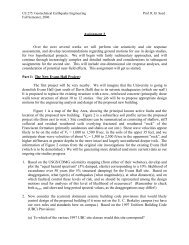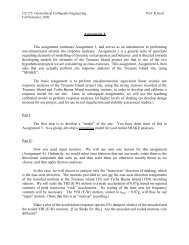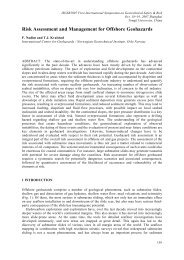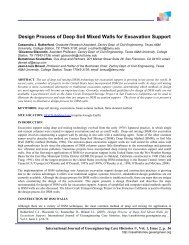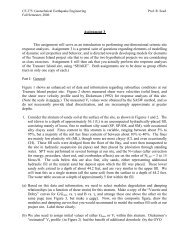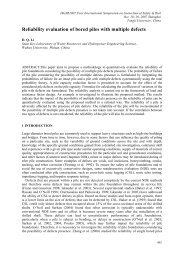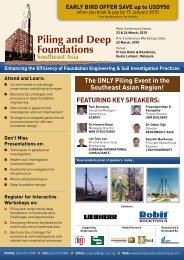Leaning Tower of Pisa: Behaviour after Stabilization Operations
Leaning Tower of Pisa: Behaviour after Stabilization Operations
Leaning Tower of Pisa: Behaviour after Stabilization Operations
- No tags were found...
Create successful ePaper yourself
Turn your PDF publications into a flip-book with our unique Google optimized e-Paper software.
first by means <strong>of</strong> physical models, then by numerical modelling and finally by means <strong>of</strong> a large-scale trial (Burland et al,2000).A key finding from the above studies was that, provided soil extraction from beneath the foundation takes place north <strong>of</strong> acritical line, the response <strong>of</strong> the <strong>Tower</strong> is always positive. This critical line is located about half a radius in from thenorthern edge <strong>of</strong> the foundation (i.e. away from the leaning side).The main purpose <strong>of</strong> the large-scale trials was to develop the drilling technology for soil extraction. A drill was developedwhich consisted <strong>of</strong> a hollow-stemmed continuous flight auger housed inside a contra-rotating 168mm diameter casing (Fig.8). The arrangement permits the drill to be advanced with minimum disturbance to the surrounding ground. When a chosenlocation is reached the drill is stopped and withdrawn by about a meter leaving a cylindrical cavity. The trials showed thatthe cavities formed in the silty soil <strong>of</strong> Horizon A closed gently and that repeated extractions could be made from the samelocation. The trial foundation was successfully rotated by about 0.25 o and directional control was maintained even thoughthe ground conditions were somewhat non-uniform. Very importantly, an effective system <strong>of</strong> communication, decisionmaking and implementation was developed. This system consisted <strong>of</strong> a daily report from the site to the responsible engineer<strong>of</strong> the response <strong>of</strong> the foundation to the previous day’s soil extractions. The responsible engineer then issued a signeddocument in which the previous day’s response was summarized and analysed, the objectives <strong>of</strong> the coming day’s soilextraction were set out and instructions given for the locations and volumes <strong>of</strong> the next soil extractions.In August 1998 the Committee agreed to carry out limited soil extraction from beneath the <strong>Tower</strong> with a view to observingits response. This preliminary underexcavation was to be carried out over a limited width <strong>of</strong> 6m north <strong>of</strong> the <strong>Tower</strong> usingtwelve bore holes lined with 219mm diameter casings (Fig. 9). On 9th February 1999, in an atmosphere <strong>of</strong> great tension,the first soil extraction took place. The <strong>Tower</strong> slowly began to rotate northwards. When the northward rotation had reachedabout 80 arc seconds by early June 1999 the preliminary soil extraction was stopped. Northward rotation continued at adecreasing rate until October 1999.The success <strong>of</strong> the preliminary underexcavation persuaded the Committee that it was safe to undertake soil extraction overthe full width <strong>of</strong> the foundation. Accordingly, between December 1999 and January 2000, 41 extraction holes wereinstalled north <strong>of</strong> the <strong>Tower</strong> at 0.5m spacing with a dedicated auger and casing in each hole (Fig.10). Full underexcavationcommenced on 21st February 2000 and the <strong>Tower</strong> was steered northwards in a remarkably straight path. Towards the end<strong>of</strong> May 2000 progressive removal <strong>of</strong> the lead ingots was commenced. Although this resulted in an increase <strong>of</strong> overturningmoment the soil extraction continued to be effective.On 16th January 2001 the last lead ingot was removed from the post-tensioned concrete ring and there<strong>after</strong> only limited soilextraction was undertaken. In the middle <strong>of</strong> February 2001 the concrete ring itself was removed and at the beginning <strong>of</strong>March progressive removal <strong>of</strong> the augers and casings commenced with the holes being filled by a bentonitic grout. Thefinal extraction and auger removal took place on 6th June 2001 at which time the <strong>Tower</strong> had been rotated northwards byabout 1800 arc seconds, see Fig. 11. Full details <strong>of</strong> the soil extraction operation and the associated response <strong>of</strong> the <strong>Tower</strong>are given by Burland et al, (2003).Figure 8. Tool for ground extraction.International Journal <strong>of</strong> Geoengineering Case Histories ©, Vol. 1, Issue 3, p. 162http://casehistories.geoengineer.org



